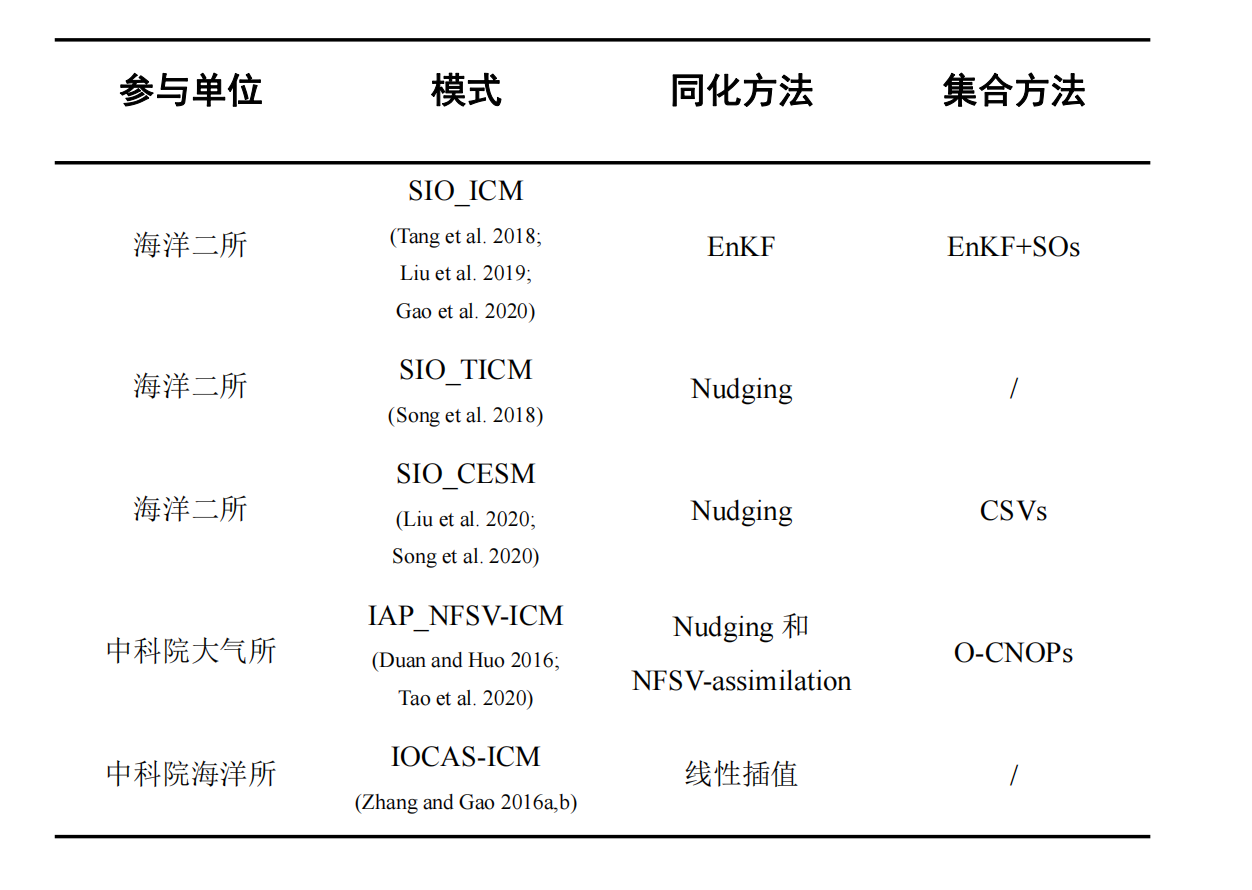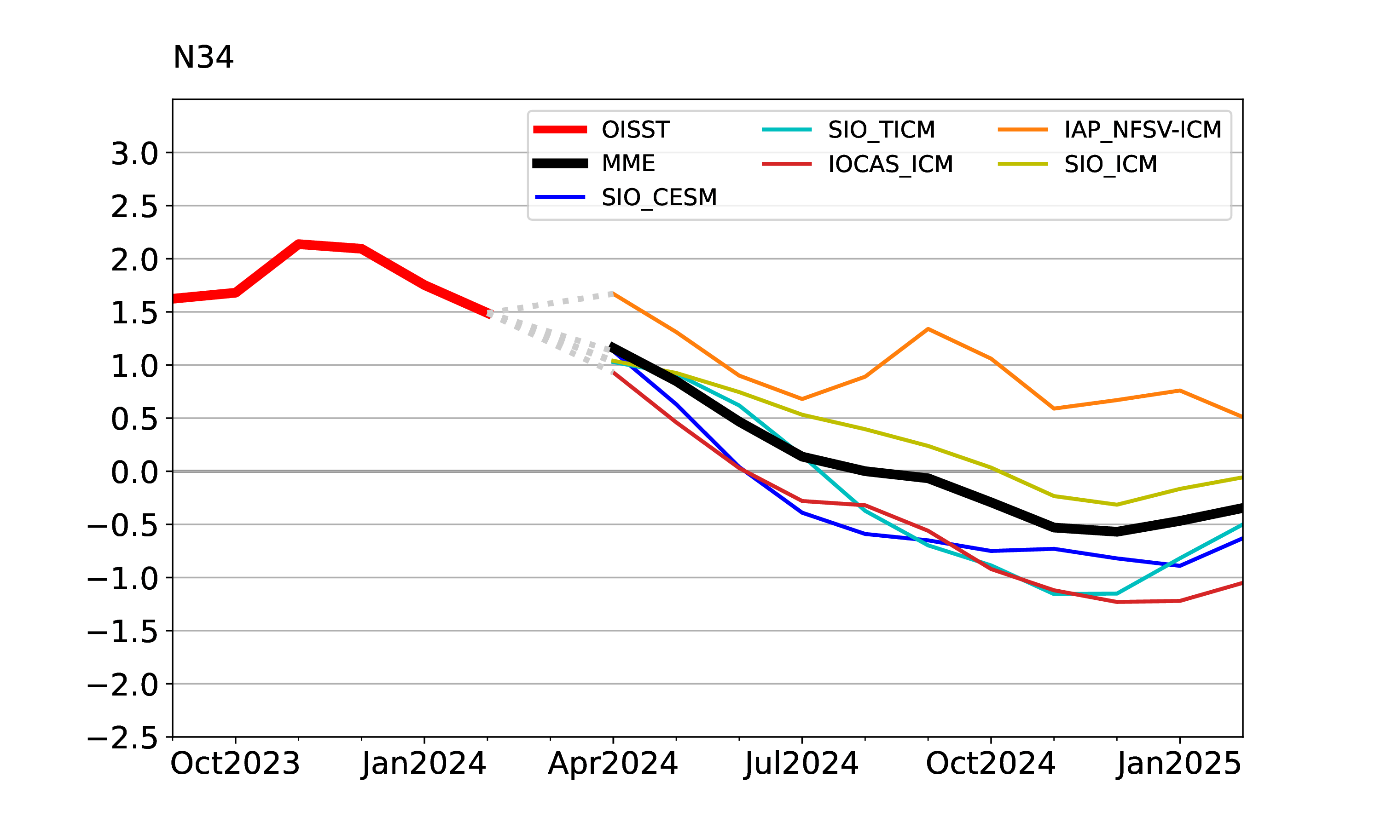以自然资源部第二海洋研究所卫星海洋环境动力学国家重点实验室作为依托单位,由陈大可院士任首席的国家自然科学基金委重大项目“ENSO的变异机理和可预测性研究”(41690120)第四课题研发的ENSO多模式集合预报系统研发取得重要进展,目前系统已完成测试、评价,并开展实时预报。
该多模式系统包含项目参与单位海洋二所陈大可团队、中科院大气所段晚锁团队和中科院海洋所张荣华团队发展的5个不同复杂程度的海气耦合模式(表1),各模式分别采用集合卡尔曼滤波(EnKF)、非线性强迫奇异向量同化(NFSV-assimilation; Tao et al., 2019)、Nudging同化以及线性插值方法同化大气、海洋资料进行模式初始化。利用随机最优扰动(Stochastic optimals,简称SOs,Kleeman and Moore 1997)、气候相关的奇异向量(Climatically relevant singular vectors,简称CSVs,Kleeman et al. 2003;Tang et al. 2006)和正交条件非线性最优扰动(Orthogonal Conditional Nonlinear Optimal Perturbations,简称O-CNOPs,Duan and Huo 2016)的集合方法度量初始条件或模式误差的不确定性,并产生集合成员。过去一个多世纪的回报试验结果表明:该系统Niño3.4指数的预报技巧已进入国际ENSO预测水平的第一梯队,提前6个月的预报技巧能够达到0.83,提前12个月能够达到0.59,系统能够提前12个月提供有效的ENSO预报。
该系统已与2020年9月开始定期开展实时预报,2024年3月的预报结果显示,未来热带太平洋地区拉尼娜状态将维持(图1)。
表1 多模式ENSO集合系统模式信息一览表


图1 多模式ENSO集合系统2024年3月起报的确定性预报结果
免责申明:
气候预测数据产品由预测,计算产生,具有一定误差。气候预测信息仅供用户作为生产、生活和科研的参考信息。用户据此做出的行为以及对您或第三方造成的损失本网站及其关联单位不承担责任。
参考文献:
[1] Duan W.S., Z.H. Huo, 2016: An approach to generating mutually independent initial perturbations for ensemble forecasts: orthogonal conditional nonlinear optimal perturbations. J. Atmos. Sci., 73, 997-1014.
[2] Kleeman R., and A. Moore, 1997: A theory for the limitation of ENSO predictability due to stochastic atmospheric transients. J. Atmos. Sci., 54, 753–767.
[3] Kleeman R., Y.M. Tang, and A. Moore, 2003: The calculation of climatically relevant singular vectors in the presence of weather noise. J. Atmos. Sci., 60, 2856–2867.
[4] Gao Y.Q., T. Liu, X.S. Song, Z.Q. Shen, et al., 2020: An extension of LDEO5 model for ENSO ensemble predictions. Clim. Dyn., 55, 2979–2991.
[5] Liu T., Y.M. Tang, D.J. Yang, Y.J. Cheng et al., 2019: The relationship among probabilistic, deterministic and potential skills in predicting the ENSO for the past 161 years. Clim. Dyn., 53, 6947–6960.
[6] Liu T., Y. M. Tang, Song XS. Z.Q. Shen et al., 2020: ENSO predictability in the CESM model from 1880 to 2017. Submitted to J. Climate.
[7] Song X.S., D. Chen, Y.M. Tang, and T. Liu, 2018: An intermediate coupled model for the tropical oceans. Science China (Earth Sciences), 61, 1859-1874.
[8] Song X.S., Li X.J., Zhang S.W., et.al., 2020: A new nudging scheme for the current operational climate prediction system in National Marine Environmental Forecasting Center of China. Submitted to Science China Earth Sciences.
[9] Tang Y.M., R. Kleeman, and S. Miller, 2006: ENSO predictability of a fully coupled GCM model using singular vector analysis. J Climate, 19, 3361-3377.
[10] Tang Y.M., R.H. Zhang, T. Liu, W.S. Duan et al., 2018: Progress in ENSO prediction and predictability study. National Science Review, 5: 826-839.
[11] Tao L.J., W.S. Duan, and S. Vannitsem, 2020: Improving forecasts of El Niño diversity: a nonlinear forcing singular vector approach. Clim. Dyn. 55, 739–754.
[12] Zhang R.H., C. Gao, 2016a: The IOCAS intermediate coupled model (IOCAS ICM) and its real-time predictions of the 2015–2016 El Niño event. Sci. Bull., 61, 1061–1070.
[13] Zhang R.H., C. Gao, 2016b: Role of subsurface entrainment temperature (Te) in the onset of El Niño events, as represented in an intermediate coupled model. Clim. Dyn., 46, 1417–1435.
© 2021卫星海洋环境动力学国家重点实验室 版权所有.
浙ICP备10040255号-4 流量统计
